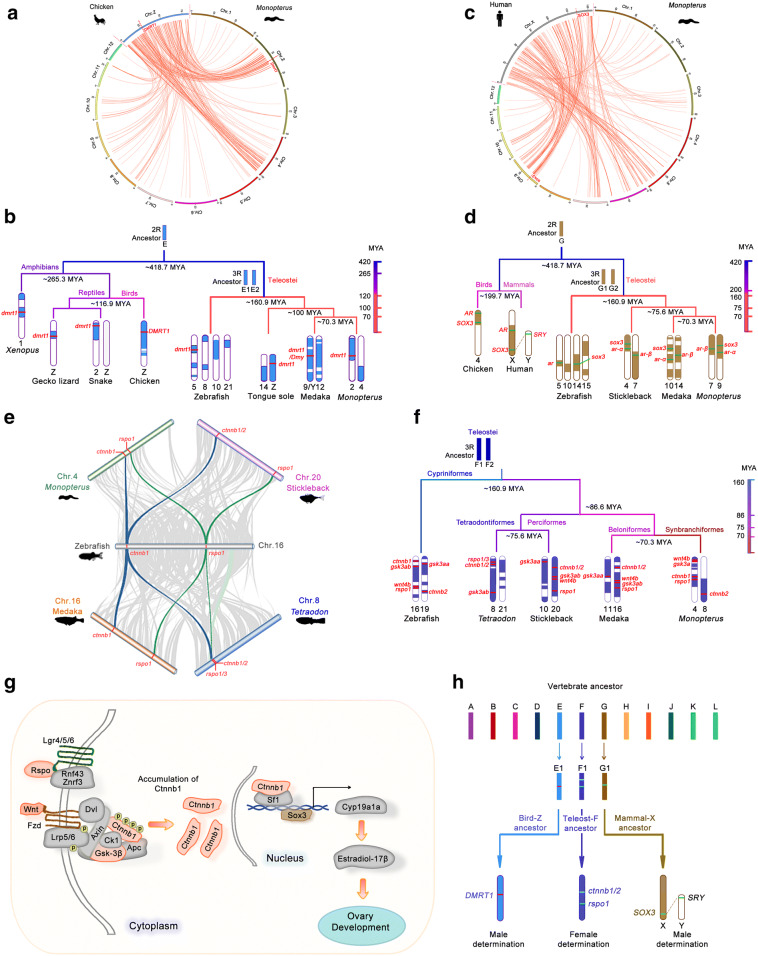Fig. 3.
Evolution of chromosome Fs and multiple independent origins of conserved blocks related to sex-determining genes. a Circos shows the syntenic relationships of the ohnologous genes between the chicken Z and Monopterus albus chromosomes. Red inner links show the ohnologous genes between the chromosomes in Monopterus albus corresponding to the chicken Z chromosome. The male-determining gene dmrt1 is highlighted in red. b The schematic diagram depicts the evolutionary trajectory of the syntenic blocks of the bird-like Z chromosome in birds (chicken), reptiles (gecko lizard and snake), amphibians (Xenopus) and teleost fishes from the ancestral chromosome E in 2R approximately 418.7 MYA. Syntenic blocks shared with the bird-like Z chromosome are shown in blue. The male-determining gene dmrt1 is highlighted in red. An estimated divergence time ruler in MYA is shown on the right. c Syntenic relationships of the ohnologous genes between the human X and Monopterus albus chromosomes. Red inner links show the ohnologs between the chromosomes in Monopterus albus corresponding to the human X chromosome. SOX3, an ancestor gene of the approximately sex-determining gene SRY, is highlighted in red. d Evolutionary trajectory of the syntenic blocks of the human X chromosome in chicken and teleost fishes, from the ancestor chromosome G in 2R approximately 418.7 MYA. Syntenic blocks shared with the X chromosome are shown in brown. The male-determining gene SRY on chromosome Y approximately evolved from SOX3 on chromosome X in mammals. The chromosomal regions of representative markers SOX3 and AR are conserved across species. An estimated divergence time ruler in MYA is shown on the right. e Conserved synteny among chromosome 16 in zebrafish, chromosome 8 in Tetraodon, chromosome 20 in stickleback, chromosome 16 in medaka and chromosome 4 in Monopterus albus, analyzed by the JCVI software package. Syntenic blocks of ≥ 5 genes shared among the species are shown in links. Blue links indicate blocks with β-catenin (ctnnb1); green links indicate blocks with rspo1. Tetraodon has only one rspo gene in its genome, homologous to zebrafish rspo1 and 3. Chromosome datasets of zebrafish, Tetraodon, stickleback and medaka were obtained from Ensembl (release 95). f Evolution of the chromosome Fs in the teleost lineage. The ancestor chromosome F in 2R generated a pair of chromosomes, F1 and F2, when the 3R WGD occurred approximately 300 MYA. The chromosome Fs are conserved in teleosts, which include chromosome 16 in zebrafish, chromosome 8 in Tetraodon, chromosome 20 in stickleback, chromosome 16 in medaka and chromosome 4 in Monopterus albus. Key genes in the female determination pathway (rspo1, ctnnb1, wnt4b and gsk3a) conserved on the chromosome Fs across species are highlighted in red. In Tetraodon, wnt4b is on a scaffold and has not yet been mapped onto chromosomes. An estimated divergence time ruler in MYA is shown on the right. g The Rspo1/Wnt/Ctnnb1 signaling pathway for female sex determination in teleosts. Key factors in the pathway from the chromosome Fs are highlighted in red. In the model, Rspo1 binds cell surface receptors Znrf3/Rnf43 and LGR4/5/6 and inhibits the ubiquitin E3 ligase activities of Znrf3/Rnf43, which leads to stacking of Fzd receptors on the membrane. The accumulation of Fzd can recruit enough of the Wnt ligands and trigger the Wnt signaling response. The signal is then relayed to the downstream complex of phosphorylation and ubiquitination consisting of Gsk3b/Ck1/Dvl/Axin1/Apc in the cytoplasm. Gsk3b and Ck1 phosphorylate Ctnnb1, which is captured by the degradation complex for ubiquitination. Within the large complex, modified Ctnnb1 saturates and inactivates the degradation complex, allowing newly synthesized, unmodified Ctnnb1 to accumulate in the cytoplasm. The Ctnnb1 is then translocated into the nucleus to activate transcription of downstream Wnt target genes, such as cyp19a1a. Ctnnb1 as a cofactor, in association with transcription factor Sf1, activates transcription of cyp19a1a. Sox3 can also bind to the promoter of cyp19a1a and up-regulate cyp19a1a expression. Thus, both Ctnnb1 and Sox3 promote the Cyp19a1a-17β-E2 pathway for ovary development. h Multiple independent origins of blocks related to sex determination genes. The bird-like Z chromosome originated from ancestor chromosome E. The syntenic blocks with male-determining gene DMRT1 on it are conserved in vertebrates. The mammalian X/Y chromosomes originated from ancestor chromosome G. The ancestor chromosome F generated the chromosome Fs with female-determining genes ctnnb1/2 and rspo1 in the teleost lineage

